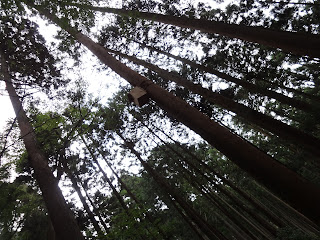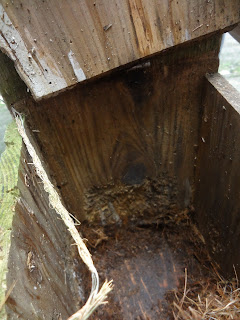For 2019, my Japanese New Year decoration takes more traditional approach. I made a decoration with rice straw called Shinenawa 注連縄, Urajiro fern (Gleichenia japonica), branches of Sakaki tree (Cleyera japonica), leaves of Yuzuriha tree (Daphniphyllum macropodum), berries of Senryo (Sarcandra glabra) and Manryo trees (Ardisia crenata), and a hand-made paper decoration (Shide 紙垂 of Gohei 御幣) for Shintoism rituals. Basically, Japanese New Year decoration is to welcome a god of New Year visiting home who can bring souvenir of good luck for the entire year. Inevitably, all traditional ingredients for the decoration have a ceremonial meaning.
 |
| My 2019 New Year decoration |
Shimenawa is to create a purified space inside in order to invite something sacred. In Niiharu Citizen Forest 新治市民の森, we Lovers of Niiharu Citizen Forest 新治市民の森愛護会 weaved sacred festoons from straws of rice cultivated by our sibling volunteer organization, Niiharu Association for Protecting Traditional Rice Paddies 新治谷戸田を守る会. My seniors of Niiharu Lovers told me these days getting hold of straws is VERY difficult in Japan. In general, professional rice cultivation is mechanized a lot. When farmers harvest rice, they do it by machine that mows and thresh rice in one go. In the process, the leaves and stems of rice are finely chopped and sprinkled over paddies, which certainly does well for fertilizing soil efficiently … But no straw can be created. “So, all the commercial Japanese traditional New Year Decorations with straw are made in China, you know. In contrast, ours is purely made-in Niiharu, organic!” Hmmmmmm. No wonder we find straws in farmers market with a price tag 6000 yen (60 USD) for about 500g. Oh, by the way, I posted how to weave Japanese New Year festoon on February 3rd of 2017. If you can obtain straws, please try. The weaving is a fun!
 |
| A
scene of supermarket selling Japanese New Year decorations. So, all of these would be made of products from China. |
Urajiro fern has large leaves that “Shidareru” or droop in a forest. In Japanese pronunciation, drooping, “Shidaru,” has homonym meaning “aging gracefully, 齢垂る.“ i.e. Suitable to celebrate adding one more year in the coming year, isn’t it? Sakaki branches are regulars for Shitoism shrine as Japanese goods love to come to ever-green (i.e. “eternal life”) trees of symmetrical shape with pointed branch and leaf tops. Hey, they are gods with strict aesthetics. Leaves of Yuzuriha tree have characteristic in generation change: they shed the old ones at once when new leaves are well-established. Ancient Japanese saw it as an ideal way to yield reins of anything to younger generation. Thus they are used for sacred decoration of New Year: old year goes, and new year comes. Senryo and Manryo are names of plants but also means “tons of money” in Japanese. Good for coming year’s upward business cycle, for sure. Shide is another squaddie for Shitoism. It is said that it symbolizes thunderclap. Japanese farmers thought when there are lots of thunderbolts, it’s a divine sign of bumper crops, and so for the ritual. (I don’t know scientific evidence for this.) All of them are telling traditional Japanese psyche, aren’t they?
 |
| A wild Manryo tree |
About thunders and storms, I’ve recently learned a good interactive site to see how aerosols came and went depending on weather. The case in point: sea salt showered over our forests in Kanagawa last October. The data is gathered by satellites 24/7, and NASA made the information available in graphics. To access the site,
- Open NASA World View here.
- Go to ‘Add Layers’ and under ‘Hazard and Disaster’ tab choose ‘Air Quality’, then ‘Aerosol Index’. On the left-hand side choose ‘Suomi NPP/OMPS’, then tick the box for ‘Aerosol Index’. Once you have done this, close the pop-up box by clicking the x.
- Select the date at the bottom. I checked what happened in the first week of this October around Tokyo. We can see the high amounts of aerosols (shown in bright yellow and red). Moving the date from September 30th to October 7th focus on Kanagawa Prefecture, we are able to recognize how super typhoon Trami moved aerosols, i.e. sea salts. That’s the reason our broad-leaved trees were browned after the typhoon!
This site also can show the other incidents like forest fires, volcanic eruptions, PM2.5 in China, etc. It’s fun to play around with it. 😄
 |
| October 1, 2018, Kanto Region of Japan from the space … |
And so,
2018 is coming to close. For the finale, last week I stayed in a hospital to
remove titanium pegs from my right wrist. I was astounded to find such a big
metal was screwed on my wrist bone … My orthopedic surgeon told me there are now 8
peg-holes there. I have to take lots of Ca, Vitamin D, Protein, etc. + plenty
of sunshine to fill the cavity with newly growing bones. The prescription is
obliged. I think I’ve become more cautious and prudent under cold winter
sunshine … so I hope. A lesson to be learned:
PLEASE DO NOT BREAK YOUR BONE, NEVER! |
| It’s too large … |
 |
| I am
recovering by eating these chix kebabs of Lawson Convenience Stores … Protain, Ca, … |
Happy
2019!
 |
| Strikingly
red berries of Solanum lyratum. Come to think of it, winter forests in Kanagawa Prefecture have lots of cute red berries. |
If you find an environmental issues
in Kanagawa Prefecture, please make a contact with Kanagawa Natural Environment Conservation Center 神奈川県自然環境保全センター
657 Nanasawa, Atsugi City, 243-0121 〒243-0121 厚木市七沢657
Phone: 046-248-0323












































